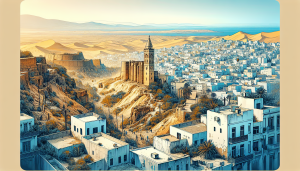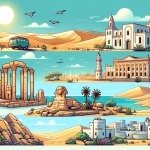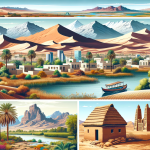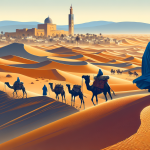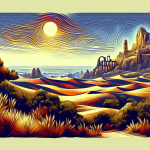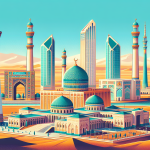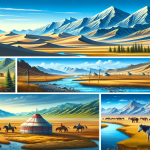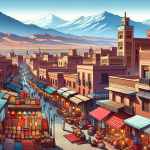Exploring Tunisia: A Travel Blogger’s Guide to the Jewel of North Africa
Tunisia, often referred to as the jewel of North Africa, is a captivating destination that offers a unique blend of history, culture, and natural beauty. This small yet diverse country is nestled between the Mediterranean Sea and the Sahara Desert, making it an ideal spot for travelers seeking both relaxation and adventure. From the ancient ruins of Carthage to the bustling markets of Tunis, Tunisia offers a rich tapestry of experiences that cater to all types of travelers. In this comprehensive guide, we’ll explore the myriad attractions that make Tunisia a must-visit destination, including its historical sites, natural wonders, and vibrant cities. We’ll also delve into practical travel tips, such as the best times to visit, local customs, and essential travel logistics. Whether you’re a history buff, a nature enthusiast, or simply looking for a unique cultural experience, Tunisia has something to offer everyone. So pack your bags and get ready to discover the enchanting land of Tunisia.
The Historical Marvels of Tunisia
One of the most compelling reasons to visit Tunisia is its **rich historical heritage**. The country is home to numerous UNESCO World Heritage Sites, each offering a glimpse into its storied past. From ancient Roman ruins to well-preserved Islamic architecture, Tunisia’s historical landmarks are nothing short of awe-inspiring.
The Ancient City of Carthage
No visit to Tunisia would be complete without exploring the ancient city of Carthage. Founded in the 9th century BC, Carthage was once a powerful city-state and a major rival to Rome. Today, the ruins of Carthage are a testament to its former grandeur. Visitors can wander through the remnants of the city’s ancient streets, marvel at the massive amphitheater, and explore the ruins of the Antonine Baths. The Carthage National Museum offers a wealth of artifacts that provide further insight into this fascinating civilization.
El Djem Amphitheatre
Another must-visit historical site in Tunisia is the El Djem Amphitheatre. This Roman colosseum, one of the largest in the world, is remarkably well-preserved and offers a fascinating glimpse into the grandeur of the Roman Empire. Visitors can walk through the ancient corridors, stand in the arena where gladiators once fought, and climb to the upper tiers for a panoramic view of the surrounding countryside. The nearby El Djem Museum houses a collection of Roman mosaics and artifacts, adding further context to this impressive site.
The Medina of Tunis
The Medina of Tunis, a UNESCO World Heritage Site, is a vibrant maze of narrow streets, bustling markets, and historic buildings. This ancient quarter of the capital city is a treasure trove of Islamic architecture, with numerous mosques, palaces, and madrasas to explore. The Zitouna Mosque, one of the oldest in Africa, is a particular highlight. Visitors can also browse the souks, or traditional markets, where they can find everything from spices and textiles to jewelry and handicrafts. The Medina is not just a historical site; it’s a living, breathing part of the city that offers a glimpse into the daily life and culture of Tunisia.
Natural Wonders of Tunisia
Tunisia’s diverse landscapes offer a wealth of natural beauty to explore, from stunning coastlines to the vast expanse of the Sahara Desert. Whether you’re seeking relaxation on pristine beaches or adventure in the great outdoors, Tunisia’s natural wonders have something to offer everyone.
The Mediterranean Coast
Tunisia’s Mediterranean coastline is a paradise for beach lovers. The country boasts miles of sandy shores, crystal-clear waters, and charming coastal towns. Hammamet, with its beautiful beaches and luxury resorts, is a popular destination for sun-seekers. The picturesque village of Sidi Bou Said, perched on a cliff overlooking the sea, is famous for its whitewashed houses and blue shutters. Further south, the island of Djerba offers a more laid-back vibe, with its tranquil beaches, traditional architecture, and vibrant markets.
The Sahara Desert
The Sahara Desert, one of the most iconic landscapes in the world, covers a vast portion of southern Tunisia. Adventurous travelers can embark on a desert safari, exploring the dunes by camel or 4×4 vehicle. The town of Douz, known as the “Gateway to the Sahara,” is a popular starting point for desert expeditions. Visitors can also explore the stunning salt flats of Chott El Jerid, where the shimmering mirages create an otherworldly landscape. For a truly unique experience, spend a night in a traditional desert camp, where you can enjoy stargazing and traditional Bedouin hospitality.
The Atlas Mountains
The Atlas Mountains, which run through the northern part of Tunisia, offer a striking contrast to the country’s coastal and desert landscapes. This mountain range is a haven for outdoor enthusiasts, with opportunities for hiking, trekking, and bird-watching. The charming town of Ain Draham, nestled in the heart of the mountains, is a popular destination for nature lovers. The nearby Ichkeul National Park, a UNESCO World Heritage Site, is home to a diverse array of wildlife, including migratory birds, wild boar, and Barbary macaques. The park’s picturesque lake and lush wetlands provide a peaceful retreat from the hustle and bustle of city life.
Vibrant Cities and Cultural Experiences
Tunisia’s cities offer a vibrant mix of old and new, with historic landmarks, modern amenities, and a rich cultural scene. From the bustling capital of Tunis to the coastal gems of Sousse and Monastir, Tunisia’s cities are full of surprises and delights.
Tunis: The Capital City
Tunis, the capital of Tunisia, is a bustling metropolis that seamlessly blends the old and the new. The city’s historic Medina is a UNESCO World Heritage Site, with its labyrinthine streets, bustling souks, and stunning Islamic architecture. The Bardo Museum, housed in a former palace, is home to one of the world’s most important collections of Roman mosaics. The modern part of the city offers a range of shopping, dining, and entertainment options, with chic cafes, trendy boutiques, and vibrant nightlife. The Avenue Habib Bourguiba, often referred to as the “Champs-Élysées of Tunis,” is a lively boulevard lined with shops, cafes, and historic landmarks.
Sousse: The Pearl of the Sahel
Sousse, located on the eastern coast of Tunisia, is known as the “Pearl of the Sahel” due to its stunning coastline and rich history. The city’s Medina, a UNESCO World Heritage Site, is a maze of narrow streets, bustling markets, and historic buildings. The Ribat, a fortified monastery, offers panoramic views of the city and the sea. Sousse is also famous for its beaches, with miles of golden sand and clear blue waters. The city’s modern marina, Port El Kantaoui, is a popular destination for water sports, dining, and shopping.
Monastir: A Blend of History and Modernity
Monastir, another coastal gem, offers a delightful blend of history and modernity. The city’s most famous landmark is the Ribat of Monastir, a well-preserved fortress that dates back to the 8th century. Visitors can explore the fortress’s towers, chambers, and courtyards, and enjoy stunning views of the sea and the city. Monastir is also home to a beautiful marina, a bustling market, and a range of modern amenities. The nearby Monastir International Airport makes it a convenient destination for travelers.
Practical Travel Tips for Tunisia
Planning a trip to Tunisia involves more than just choosing your destinations. To make the most of your visit, it’s important to be aware of local customs, travel logistics, and practical considerations. Here are some essential travel tips to help you navigate your Tunisian adventure.
Best Times to Visit
The best time to visit Tunisia depends on your interests and the activities you have planned. The spring (March to May) and autumn (September to November) are ideal for exploring the country’s historical sites and natural wonders, as the weather is mild and pleasant. The summer months (June to August) are perfect for beach vacations, with warm temperatures and plenty of sunshine. However, be prepared for high temperatures, especially in the desert regions. The winter months (December to February) are cooler, making it a good time for desert expeditions and outdoor activities in the mountains.
Local Customs and Etiquette
Understanding local customs and etiquette is essential for a respectful and enjoyable visit to Tunisia. The majority of Tunisians are Muslim, and it’s important to dress modestly, especially when visiting religious sites. Women should cover their shoulders and knees, and men should avoid wearing shorts. It’s also customary to greet people with a friendly “As-salamu alaykum” (peace be upon you) and to show respect for elders. When visiting someone’s home, it’s polite to remove your shoes and to bring a small gift, such as sweets or flowers. Tipping is appreciated in restaurants and for services, with 10% being a standard amount.
Travel Logistics
Tunisia is well-connected by air, with international flights arriving at Tunis-Carthage International Airport, Monastir International Airport, and Djerba-Zarzis International Airport. The country also has an extensive network of buses and trains, making it easy to explore different regions. Car rentals are available, but driving can be challenging due to traffic and road conditions. Taxis are a convenient option for getting around cities, and it’s advisable to agree on a fare before starting your journey. The local currency is the Tunisian dinar (TND), and it’s best to carry some cash for small purchases, as not all places accept credit cards.
Conclusion: Discovering the Magic of Tunisia
In conclusion, Tunisia is a destination that offers a wealth of experiences for travelers of all interests. From its **rich historical heritage** and stunning natural landscapes to its vibrant cities and unique cultural experiences, Tunisia has something to offer everyone. By following these practical travel tips and exploring the country’s many attractions, you’ll be well-prepared to embark on an unforgettable journey through the jewel of North Africa. Whether you’re wandering through ancient ruins, relaxing on pristine beaches, or immersing yourself in the local culture, Tunisia promises to be a destination that will captivate your heart and leave you with lasting memories. So why wait? Start planning your Tunisian adventure today and discover the magic of this enchanting land.
For more information about traveling to Tunisia, visit Tunisia Tourism.
